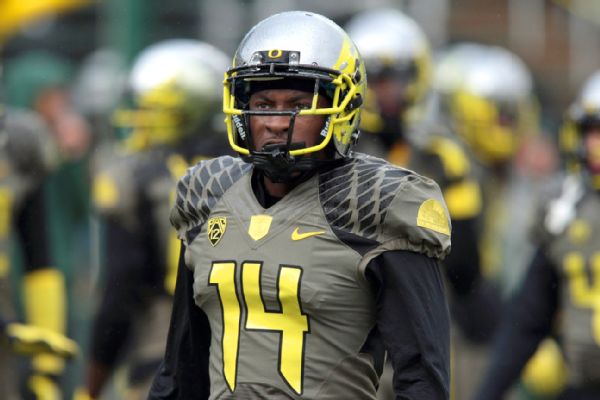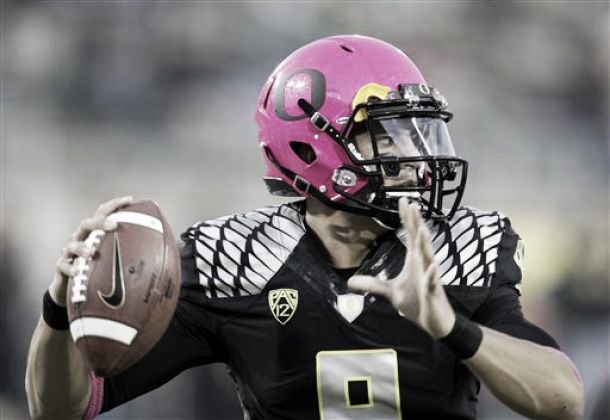Two seasons ago, the Oregon Ducks came literally within inches of a berth in the BCS championship game. Last year, hiccups against Stanford (again) and Arizona left the Ducks on the outside looking in.
Marcus Mariota could have entered the NFL Draft as a top pick. However, the junior signal caller and front runner for the Heisman Trophy, chose to return to Eugene in hopes of bringing the Ducks their first national championship.
Now, as a preseason top 5 team, Mariota and the Oregon Ducks are poised to do just that.

Behind the Ducks' recent success lies a fast-paced offense orchestrated by second year head coach Mark Helfrich, who served as Oregon's offensive coordinator under Chip Kelly from 2009 to 2012. Last season under Helfrich, the Ducks ranked in the nation's top ten in four offensive categories: total offense (2nd at 565 yards per game), scoring offense (4th, 45.5 points per game), passing efficiency (5th, 164.91), and rushing offense (9th, 274 yards per game).
The good news for the Ducks is that 8 starters return from that potent offensive group, led by Mariota (6300 passing yards, 1400 rushing yards, and 77 touchdowns in just two seasons) and their top three rushers, Byron Marshall, Mariota, and Thomas Tyner. Marshall is the punishing, tough yardage “thunder,” while Tyner becomes the explosive “lighting” in the Ducks’ backfield. The duo combined for over 1,700 yards and 23 touchdowns last season.
The line of scrimmage will feature all four returning linemen, including two experienced powerhouses in Jake Fisher and Hroniss Grasu. One blow dealt to the Ducks was that starting left tackle Tyler Johnstone tore his ACL in fall camp and will miss the 2014 season. His absence puts added pressure on the remainder of the linemen. Helfrich’s offensive scheme is intricate, and it will be vital for the O line to execute it properly for the Ducks to maintain their frantic pace.
Another issue for Oregon will come with its receiving corp, which enters fall camp with a question mark after losing its top four pass catchers from 2013. Top returnee Bralon Addison will miss this year after suffering a torn ACL in the off-season. That leaves an unproven group of wideouts led by Keanon Lowe who caught 18 passes last year and score three times. Darren Carrington and Devon Allen, the 2014 NCAA 110-meter-hurdle national champion, are redshirts with little experience but loads of potential. The development of pass catchers is vital as a lack of productivity will put an even greater pressure on Mariota and his offensive line to control the game.
When the ball does turn over, Oregon will sport a defense that must replace over half of last year’s starters and its departed defensive coordinator, long-time Ducks coach Nick Aliotti, who retired after their Alamo Bowl win over Texas last December. The Oregon defense is now in the hands of Don Pellum, an Aliotti protege, who himself has spent 23 years in Eugene.
Last year the Ducks allowed just 20.5 points per game, good enough for 2nd in the Pac-12 and 14th in the nation, but they finished 44th in the country in total defense, giving up 374 yards per game. The latter numbers are a bit misleading, however, as the fast paced Ducks score early and often allowing opponents more possessions throughout the season.

Cornerback Ifo Ekpre-Olomu (84 tackles, 3 interceptions in 2013), a projected first round draft pick next spring, leads an athletic but untried secondary. Arik Armstead, Derrick Malone and DeForest Buckner anchor a front seven that, by virtue of the quick-striking Ducks’ offense, can peel back its ears and get to the opposing quarterback.
Against Texas, Oregon showed the ability to shut down the running game which had proved to be the team’s demise against both Stanford and Arizona. However, depth will be a key for the Oregon defense. While the top 11 are solid, there are still unanswered questions about the back-ups.
All things considered, Pellum is optimistic about his side of the ball.
"We're close to where we should be at this point," Pellum said of his Ducks D after Oregon’s early fall practices. "We love our attitude. The kids' attitude is really good and we love the way they're progressing."
So the 2014 Oregon Ducks have a Heisman Trophy candidate for a quarterback, a stout O line, versatile running backs, and what looks to be a stingy, ball-hawking defense.
But what will get them over the hump this year?
Blue Collars.
Helfrich knows that Oregon has had one of the best teams in the nation over the last few years. He is also aware that the team has very little to show for it by way of national hardware.
So at the beginning of fall camp, among their team-issued practice gear, the Ducks found workout shirts with a particular color on the collars. Blue.
Helfrich wanted to instill in his players a desire and willingness to play with a blue collar attitude. So far the new emphasis is paying dividends.
“We made a concerted effort to [get stronger] on both sides of the ball,” Helfrich said. “On the field in the spring, I think it made an absolute difference. Defense did a great job [in the] spring, and from all accounts this summer, of raising the bar to a higher standard of accountability and effort,” Helfrich said. “In fall camp … we’ll see how that went.”
The Oregon players have responded to their coaches wishes thus far. "I think it's self explanatory,” Marshall said about the new approach. “[Helfrich] wants that blue-collar worker, a guy who is going to come to practice and work. He told us he wants to be unable to tell if we like games or practices more.”
"We know within our team why we lost two games,'' Lowe added. "And [the blue collars] is a cool representation and symbol to always keep in our minds that this is a process. There are steps on the ladder, but you can't skip steps. You can't expect to win just because of the O on the helmet.''





































